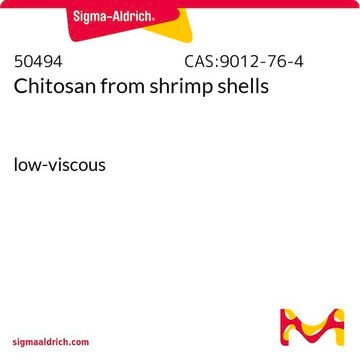As indicated in the 'PROPERTIES' section above, the molecular weight of this material may range from 310-375 kDa. The molecular weight of this material is not determined on a lot to lot basis, however historical data indicates the majority of lots will have a range of 340-360 kDa.
推荐产品
表单
(Coarse ground flakes and powder)
分子量
310000-375000 Da
粘度
800-2000 cP, 1 wt. % in 1% acetic acid(25 °C, Brookfield)(lit.)
溶解性
H2O: insoluble
organic solvents: insoluble
SMILES字符串
N([C@H]1[C@@H](O[C@@H]([C@H]([C@@H]1O)O[C@@H]4O[C@@H]([C@H]([C@@H]([C@H]4N)O)O[C@@H]5O[C@@H]([C@H]([C@@H]([C@H]5N)O)O[C@@H]6O[C@@H]([C@H]([C@@H]([C@H]6N)O)O[C@@H]7O[C@@H]([C@H]([C@@H]([C@H]7N)O)O[C@@H]8O[C@@H]([C@H]([C@@H]([C@H]8N)O)O[C@@H]9O[C@@H]([C@H](
InChI
1S/C56H103N9O39/c1-87-56(86)65-28-38(84)46(19(10-74)96-55(28)104-45-18(9-73)95-49(27(64)37(45)83)97-39-12(3-67)88-47(85)20(57)31(39)77)103-54-26(63)36(82)44(17(8-72)94-54)102-53-25(62)35(81)43(16(7-71)93-53)101-52-24(61)34(80)42(15(6-70)92-52)100-51-23(60)33(79)41(14(5-69)91-51)99-50-22(59)32(78)40(13(4-68)90-50)98-48-21(58)30(76)29(75)11(2-66)89-48/h11-55,66-85H,2-10,57-64H2,1H3,(H,65,86)/t11-,12-,13-,14-,15-,16-,17-,18-,19-,20-,21-,22-,23-,24-,25-,26-,27-,28-,29-,30-,31-,32-,33-,34-,35-,36-,37-,38-,39-,40-,41-,42-,43-,44-,45-,46-,47-,48+,49+,50+,51+,52+,53+,54+,55+/m1/s1
InChI key
FLASNYPZGWUPSU-SICDJOISSA-N
正在寻找类似产品? 访问 产品对比指南
应用
特点和优势
外形
储存分类代码
11 - Combustible Solids
WGK
nwg
闪点(°F)
Not applicable
闪点(°C)
Not applicable
个人防护装备
Eyeshields, Gloves, type N95 (US)
商品
Carcinogenic compounds in elastomers: 1,3-butadiene and isoprene used in elastomer manufacturing, classified as carcinogenic by IARC.
Carcinogenic compounds in elastomers: 1,3-butadiene and isoprene used in elastomer manufacturing, classified as carcinogenic by IARC.
Polymers, natural or synthetic, are vital in medical advancements, contributing to device and pharmaceutical development in therapy.
Polymers, natural or synthetic, are vital in medical advancements, contributing to device and pharmaceutical development in therapy.
-
What is the molecular weight?
1 answer-
Helpful?
-
-
How is shipping temperature determined? And how is it related to the product storage temperature?
1 answer-
Products may be shipped at a different temperature than the recommended long-term storage temperature. If the product quality is sensitive to short-term exposure to conditions other than the recommended long-term storage, it will be shipped on wet or dry-ice. If the product quality is NOT affected by short-term exposure to conditions other than the recommended long-term storage, it will be shipped at ambient temperature. As shipping routes are configured for minimum transit times, shipping at ambient temperature helps control shipping costs for our customers. For more information, please refer to the Storage and Transport Conditions document: https://www.sigmaaldrich.com/deepweb/assets/sigmaaldrich/marketing/global/documents/316/622/storage-transport-conditions-mk.pdf
Helpful?
-
-
How can I determine the shelf life / expiration / retest date of this product?
1 answer-
If this product has an expiration or retest date, it will be shown on the Certificate of Analysis (COA, CofA). If there is no retest or expiration date listed on the product's COA, we do not have suitable stability data to determine a shelf life. For these products, the only date on the COA will be the release date; a retest, expiration, or use-by-date will not be displayed.
For all products, we recommend handling per defined conditions as printed in our product literature and website product descriptions. We recommend that products should be routinely inspected by customers to ensure they perform as expected.
For products without retest or expiration dates, our standard warranty of 1 year from the date of shipment is applicable.
For more information, please refer to the Product Dating Information document: https://www.sigmaaldrich.com/deepweb/assets/sigmaaldrich/marketing/global/documents/449/386/product-dating-information-mk.pdfHelpful?
-
-
What is the degree of deacetylation of this group?
1 answer-
The degree of deacetylation is not determined for this product.
Helpful?
-
-
Is it suitable for food-grade use?
1 answer-
This product is not a food grade item, it is intended for research use only. At this time, there is no food grade option available for this material.
Helpful?
-
-
What is the density of this product?
1 answer-
Unfortunately, the density is not determined for this product.
Helpful?
-
-
The source of LMW, MMW and HMW chitosan. most of the LMW and HMW chitosan were products of Iceland and MMW chitosan was a product of USA. Is there a difference in sources of crustaceans used
1 answer-
The source of all chitosan products may vary on a lot-to-lot basis. The source information is typically found on the Certificate of Origin.
Please see the DOCUMENTATION section of the product detail page and click on the "Certificate of Origin" tab to access a Certificate.https://www.sigmaaldrich.com/product/aldrich/419419#product-documentation
Helpful?
-
-
What are some uses for chitosan?
1 answer-
Chitosan is a biocompatible, antibacterial and environmentally friendly polyelectrolyte with a variety of applications including water treatment, chromatography, additives for cosmetics, textile treatment for antimicrobial activity, novel fibers for textiles, photographic papers, biodegradable films, biomedical devices, and microcapsule implants for controlled release in drug delivery. Please note that Product No. 419419 is for research purposes only, not for cosmetic or drug use.
Helpful?
-
-
What is the pH of Product 419419, Chitosan?
1 answer-
Our supplier estimates that the pH falls within the range of 6.5-8.0.
Helpful?
-
-
What is the particle size of Product 419419, Chitosan?
1 answer-
The particle size has not been determined. It is described as being course ground flakes or powder.
Helpful?
-
Active Filters
我们的科学家团队拥有各种研究领域经验,包括生命科学、材料科学、化学合成、色谱、分析及许多其他领域.
联系技术服务部门





